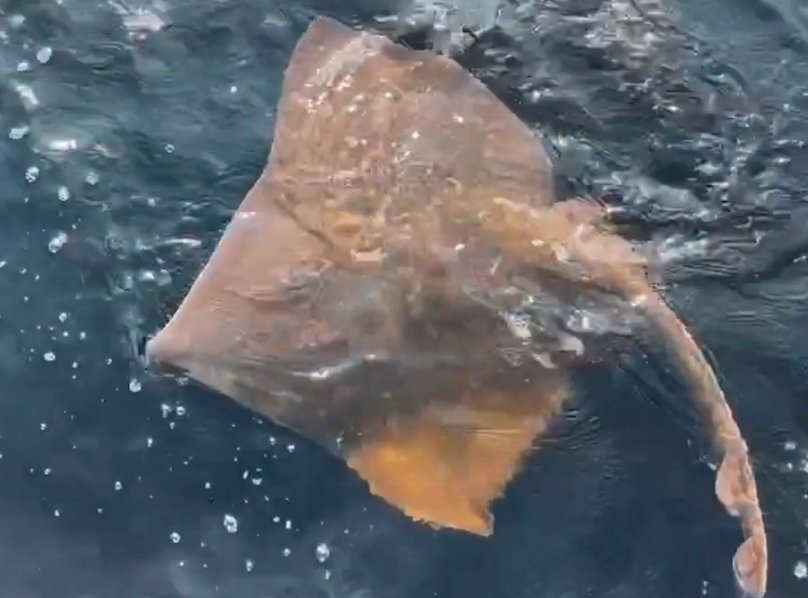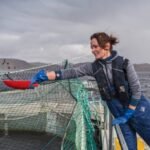Scotland’s frigid waters don’t typically come to mind as a prime diving destination. But beneath the waves, hidden among rocky crevices and seabeds, lies one of the ocean’s most endangered yet overlooked creatures—the flapper skate. Unlike the more famous basking sharks that draw divers from across the globe, this ancient species remains largely in the shadows, despite being in more danger than the giant panda.
The Elusive Giant of Scottish Waters
Most people have never heard of the flapper skate, yet it is the largest skate species in the world, reaching up to three meters in length. These prehistoric-looking fish are closely related to sharks, with broad, wing-like fins that allow them to glide gracefully through the depths. Once widespread across European waters, their population has dwindled to a fraction of what it once was, primarily due to overfishing and habitat destruction.
Finding one in the wild is a rare event. Even more astonishing is the discovery of their egg cases, often called “mermaid purses.” These leathery, rectangular cases, about the size of an American football, house developing skate embryos. Spotting just one is cause for celebration among conservationists. Finding dozens in one place? Almost unheard of.

A Dive into the Unknown
For marine conservationists Andi Cross and Chris Rickard, a recent dive off Scotland’s west coast turned into a treasure hunt. What began as an exploration of the cold, murky depths quickly transformed into a groundbreaking discovery. Scattered across the seabed, nestled between rocks, lay a collection of flapper skate eggs—an undeniable sign that this location was a crucial breeding ground.
Cross described the moment with exhilaration: “We struck gold—our version of it. We weren’t expecting to find so many in one place.”
The importance of this find cannot be overstated. These eggs take up to 18 months to hatch, making them especially vulnerable to environmental changes and human activity. Protecting these breeding grounds is essential to ensuring the species’ survival.
The Fight for Conservation
The Kilchoan Melfort Trust (KMT), a conservation-focused estate on Scotland’s rugged west coast, has taken on the challenge of protecting the flapper skate. The organization’s mission is to restore habitats and promote biodiversity while balancing rewilding efforts with sustainable land management.
Leading the skate conservation efforts at KMT are three passionate individuals—Lauren Smith, Chris Rickard, and Marnik van Cauter. Their work involves surveying the waters, monitoring egg cases, and raising awareness about the species’ plight.
“People don’t realize how close we are to losing them,” says Smith. “They’re at more risk than some of the world’s most famous endangered species, yet they remain largely ignored.”
- The flapper skate is classified as critically endangered on the IUCN Red List.
- Overfishing in the 20th century decimated their population, particularly in European waters.
- A single skate can live up to 100 years, but their slow reproductive rate makes population recovery challenging.
A Balancing Act
Protecting the flapper skate is no easy task. The waters where they are found are also used for commercial fishing, tourism, and other economic activities. Striking a balance between conservation and industry is a delicate process—one that requires cooperation from both local communities and policymakers.
The Scottish government has taken steps to establish Marine Protected Areas (MPAs), which provide some level of safeguarding for marine life, including the flapper skate. However, enforcement and awareness remain significant challenges.
| Threat | Impact on Flapper Skate |
|---|---|
| Overfishing | Reduced population numbers, habitat destruction |
| Climate Change | Affects water temperature and food sources |
| Bycatch | Skates caught unintentionally by fishing gear |
| Habitat Loss | Egg cases disturbed by human activity |
A Future for Scotland’s Forgotten Giant?
The discovery of a thriving breeding ground offers a glimmer of hope for the flapper skate. It underscores the importance of continued research, conservation efforts, and public awareness. Without intervention, this ancient species could vanish from Scottish waters within a generation.
For now, the team at KMT remains determined. Their work, combined with discoveries like Cross and Rickard’s, serves as a crucial step toward securing a future for one of the ocean’s most mysterious giants. Whether it will be enough remains to be seen, but one thing is certain: the flapper skate deserves far more attention than it gets.


















